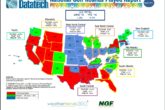
During July, I toured a 27-hole property with a member of the ASGCA. The facility offers a fabulous 18-hole championship course and a more recreational 9 hole golf course. The 9th hole of the recreational course requires you to traverse about 75 yards from the 8th green over a fence and through the woods or down a steep hill with a precarious turn for the cart, hit the tee shot and then proceed up the same cart path after playing the hole. I stated the hole appeared “forced into the landscape” and pondered why.
The 8th hole was a long par 5 that could have easily been split into a par 4 and a par 3 ending far closer to the clubhouse. The response was they wanted to ensure the par for the 9 holes was 36 for consistent with “traditional design.”
Another client that I am working with is undertaking a renovation and is strong in their belief that the course has to be a Par 72.
Instinctively, I thought the adherence to a “standard par” for 9 or 18 was a mistake.
I sincerely believe I have seen more golf courses in the world than anyone (over 5,000 courses I speculate in more 49 countries). How is that possible? Notwithstanding I have flown 2.836 million miles on United Airlines, when I secret shop a golf course for a client, I not only play their course unannounced to the staff but will visit the competitive set of upward of 20 courses in the client’s market. The more courses I see and terrible golf I watch, the conclusion that people play golf for many reasons and adherence to tradition is far down the list.
Often identifying with Dustin Hoffman’s role in “Rainman”, I tabulated the par for every golf course in the United States that has been built. The great dispersion of par will surprise you. Presented below is the par for nearly every course ever built in the United States:
| Par | # of Courses |
| 27 | 461 |
| 28 | 42 |
| 29 | 105 |
| 30 | 116 |
| 31 | 120 |
| 32 | 106 |
| 33 | 134 |
| 34 | 255 |
| 35 | 1,153 |
| 36 | 2,433 |
| 37 | 58 |
| 38 | 3 |
| 39 | 4 |
| 40 | 0 |
| 41 | 1 |
| 42 | 1 |
| 43 | 0 |
| 44 | 1 |
| 45 | 0 |
| 46 | 0 |
| 47 | 0 |
| 48 | 0 |
| 49 | 0 |
| 50 | 0 |
| 51 | 0 |
| 52 | 0 |
| 53 | 1 |
| 54 | 149 |
| 55 | 12 |
| 56 | 16 |
| 57 | 14 |
| 58 | 31 |
| 59 | 22 |
| 60 | 74 |
| 61 | 32 |
| 62 | 46 |
| 63 | 32 |
| 64 | 31 |
| 65 | 34 |
| 66 | 35 |
| 67 | 37 |
| 68 | 59 |
| 69 | 94 |
| 70 | 1,360 |
| 71 | 2,561 |
| 72 | 6,731 |
| 73 | 103 |
| 74 | 18 |
| 75 | 2 |
| 76 | 1 |
I don’t believe that financial success at a golf course is based on par but rather the experience provided. That is why I think. More importantly, what do you think? Comment below.


Dennis Lyon
I believe emphasis should always be on the quality of architecture and the golf experience. The par of a course is a consideration but should not drive architecture. A great par 4 on a par 71 course is much better than a bad par 5 on a par 72 course.
Rob Waldron
Par is only important to the USGA, the rest of us don’t give a damn!
Remember that “you cannot win golf, you can only play it”
Bagger Vance